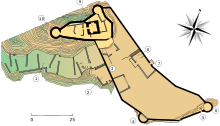Château de Puilaurens


The Château de Puilaurens (Puilaurens Castle, also Puylaurens; in
History
Origins
The castle is located on Mont Ardu. This name appears for the first time in 958 in a charter where Lothair confirms the donation of Sunifred II, Count of Urgell, lord of Fenouillèdes,[2] at the Abbey of Saint-Michel-de-Cuxa of the provostship of Puilaurens which is composed of the Boulzane valley or Sainte-Croix valley. The document also mentions the presence of a Saint-Laurent church serving as a fortified and hilltop refuge from the Carolingian period.
The first known castellan of Puilaurens is Pierre Catala who appears as a witness in the acts of Guillaume de Peyrepertuse in 1217. In 1229, Guillaume de Peyrepertuse commanded the castle of Puilaurens and, in 1242, it was held by Roger Catala, son of Pierre.
In addition to the castle, a village was built all around it, which made Puilaurens a Castle.
The Cathar presence
It is known only for the role of refuge of the castle during the Albigensian Crusade. In 1240, a woman named Saurine Rigaud, inhabitant of Fanjeaux and a Cathar believer, found refuge in Puilaurens, where she met twelve monks including eight women. In 1242, the Cathar deacon of Fenouillèdes, Pierre Paraire, stayed there. Several Perfecti were housed there from 1245 to 1246.
The annexation of the castle
Around 1250, the castle passed into the hands of the
It then becomes one of the "Five sons of Carcassonne" with the castles of Quéribus, Peyrepertuse, Château de Termes and Château d'Aguilar, all located at the top of “impregnable” rocky peaks.
After the work campaign under Louis IX, it was occupied in 1260 by the largest garrison on the entire border, under the orders of a Châtelaine, Odon de Monteuil, with a chaplain and 25 sergeants at arms[3] In 1263 there is a record of the following taken to the Chateau, ten salted pigs, two bushels of wheat, six Minots of good flour, as well as crossbows measuring two feet, four of horn and two of wood, crossbow bolts, eighteen shields, five helmets.[3]
Consolidation and fortification work continued under the leadership of Philip the Bold from 1270 to 1285.
The castle would resist several
The abandonment of the castle
Like the other sons of Carcassonne, the castle of Puilaurens was gradually abandoned following the
The castle has been listed as a
See also
References
- ^ McDonald, James. "Château de Puilaurens - Ruined Medieval Cathar Castle in France". Cathar Castles.
- ]
- ^ ISBN 978-2-7373-8461-5.
- ^ Base Mérimée: Ruines du château, Ministère français de la Culture. (in French)
Further reading
- Dieltiens, Dominique (1977). Le château de Puilaurens (Maitrise: Histoire Médiévale). Lille 3. OCLC 988575289.
External links
- Base Mérimée: Ruines du château, Ministère français de la Culture. (in French)
- "Chateau de Puilaurens". Les Sites Pays Cathare (in French).




